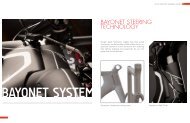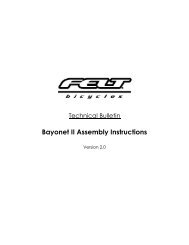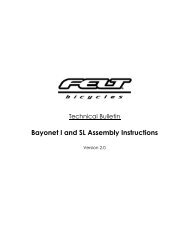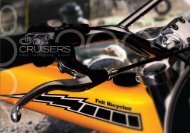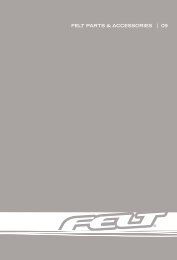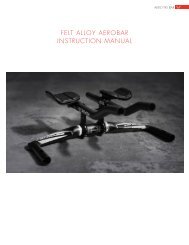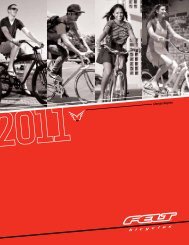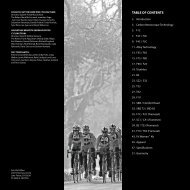Bicycle Owners Manual - Felt Bicycles
Bicycle Owners Manual - Felt Bicycles
Bicycle Owners Manual - Felt Bicycles
Create successful ePaper yourself
Turn your PDF publications into a flip-book with our unique Google optimized e-Paper software.
5. Service<br />
WARNING: Technological advances have made bicycles and bicycle<br />
components more complex, and the pace of innovation is increasing.<br />
It is impossible for this manual to provide all the information required<br />
to properly repair and/or maintain your bicycle. In order to help minimize<br />
the chances of an accident and possible injury, it is critical that you have<br />
any repair or maintenance which is not specifically described in this<br />
manual performed by your dealer. Equally important is that your individual<br />
maintenance requirements will be determined by everything from your<br />
riding style to geographic location. Consult your dealer for help in<br />
determining your maintenance requirements.<br />
WARNING: Many bicycle service and repair tasks require special<br />
knowledge and tools. Do not begin any adjustments or service on<br />
your bicycle until you have learned from your dealer how to properly<br />
complete them. Improper adjustment or service may result in damage to<br />
the bicycle or in an accident which can cause serious injury or death.<br />
If you want to learn to do major service and repair work on your bike:<br />
1. Ask your dealer for copies of the manufacturer’s installation and service<br />
instructions for the components on your bike, or contact the component<br />
manufacturer.<br />
2. Ask your dealer to recommend a book on bicycle repair.<br />
3. Ask your dealer about the availability of bicycle repair courses in your area.<br />
We recommend that you ask your dealer to check the quality of your work the<br />
first time you work on something and before you ride the bike, just to make sure<br />
that you did everything correctly. Since that will require the time of a mechanic,<br />
there may be a modest charge for this service.<br />
We also recommend that you ask your dealer for guidance on what spare<br />
parts, such as inner tubes, light bulbs, etc. it would be appropriate for you to<br />
have once you have learned how to replace such parts when they require<br />
replacement.<br />
A. Service Intervals<br />
Some service and maintenance can and should be performed by the owner,<br />
and require no special tools or knowledge beyond what is presented in this<br />
manual.<br />
The following are examples of the type of service you should perform yourself.<br />
All other service, maintenance and repair should be performed in a properly<br />
equipped facility by a qualified bicycle mechanic using the correct tools and<br />
procedures specified by the manufacturer.<br />
1. Break-in Period: Your bike will last longer and work better if you break it<br />
in before riding it hard. Control cables and wheel spokes may stretch or “seat”<br />
when a new bike is first used and may require readjustment by your dealer. Your<br />
Mechanical Safety Check (Section 1.C) will help you identify some things that<br />
need readjustment. But even if everything seems fine to you, it’s best to take<br />
your bike back to the dealer for a checkup. Dealers typically suggest you bring<br />
the bike in for a 30 day checkup. Another way to judge when it’s time for the<br />
first checkup is to bring the bike in after three to five hours of hard off-road use,<br />
or about 10 to 15 hours of on-road or more casual off-road use. But if you think<br />
something is wrong with the bike, take it to your dealer before riding it again.<br />
2. Before every ride: Mechanical Safety Check (Section 1.C)<br />
3. After every long or hard ride; if the bike has been exposed to water or grit;<br />
or at least every 100 miles: Clean the bike and lightly lubricate the chain’s rollers<br />
with a good quality bicycle chain lubricant. Wipe off excess lubricant with a lintfree<br />
cloth. Lubrication is a function of climate. Talk to your dealer about the best<br />
lubricants and the recommended lubrication frequency for your area.<br />
4. After every long or hard ride or after every 10 to 20 hours of riding:<br />
• Squeeze the front brake and rock the bike forward and back. Everything feel<br />
solid If you feel a clunk with each forward or backward movement of the bike,<br />
you probably have a loose headset. Have your dealer check it.<br />
• Lift the front wheel off the ground and swing it from side to side. Feel<br />
smooth If you feel any binding or roughness in the steering, you may have a<br />
tight headset. Have your dealer check it.<br />
• Grab one pedal and rock it toward and away from the centerline of the bike;<br />
then do the same with the other pedal. Anything feel loose If so, have your<br />
dealer check it.<br />
• Take a look at the brake pads. Starting to look worn or not hitting the wheel<br />
rim squarely Time to have the dealer adjust or replace them.<br />
• Carefully check the control cables and cable housings. Any rust Kinks<br />
Fraying If so, have your dealer replace them.<br />
• Squeeze each adjoining pair of spokes on either side of each wheel between<br />
your thumb and index finger. Do they all feel about the same If any feel loose,<br />
have your dealer check the wheel for tension and trueness.<br />
• Check the tires for excess wear, cuts or bruises. Have your dealer replace<br />
them if necessary.<br />
• check the wheel rims for excess wear, dings, dents and scratches. Consult<br />
your dealer if you see any rim damage.<br />
• Check to make sure that all parts and accessories are still secure, and<br />
tighten any which are not.<br />
• Check the frame, particularly in the area around all tube joints; the<br />
handlebars; the stem; and the seatpost for any deep scratches, cracks or<br />
discoloration. These are signs of stress-caused fatigue and indicate that a part is<br />
at the end of its useful life and needs to be replaced. See also Appendix B.<br />
WARNING: Like any mechanical device, a bicycle and its components<br />
are subject to wear and stress. Different materials and mechanisms<br />
wear or fatigue from stress at different rates and have different life<br />
cycles. If a component’s life cycle is exceeded, the component can<br />
suddenly and catastrophically fail, causing serious injury or death to the<br />
rider. Scratches, cracks, fraying and discoloration are signs of stresscaused<br />
fatigue and indicate that a part is at the end of its useful life and<br />
needs to be replaced. While the materials and workmanship of your bicycle<br />
32 33




